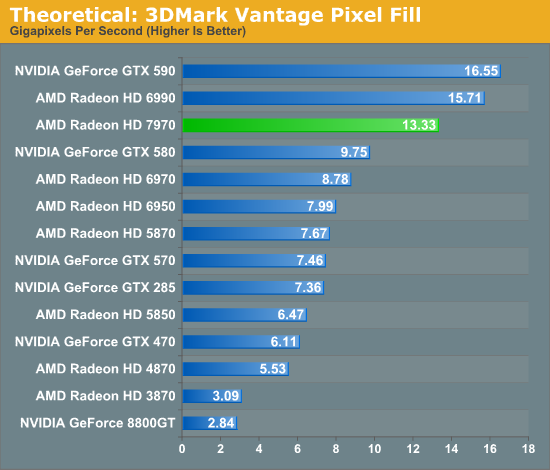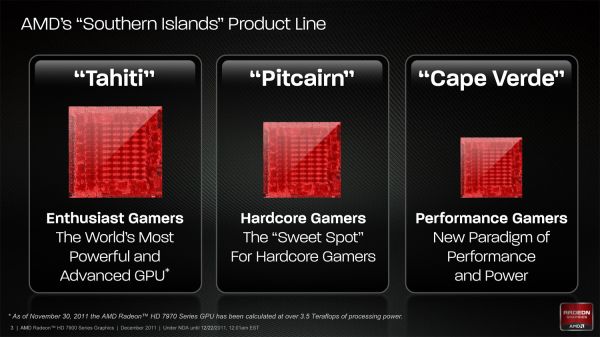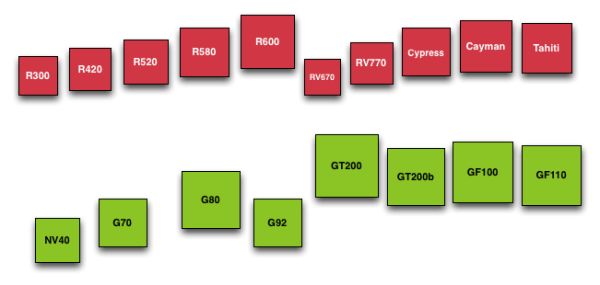AMD Radeon HD 7970 Review: 28nm And Graphics Core Next, Together As One
by Ryan Smith on December 22, 2011 12:00 AM EST- Posted in
- GPUs
- AMD
- Radeon
- ATI
- Radeon HD 7000
Building Tahiti & The Southern Islands
Now that we’ve had a chance to go over the basis of the Graphics Core Next architecture, let’s talk about the finished products.
Today AMD will be launching Tahiti, the first GPU of the Southern Islands family. Southern Islands will initially be composed of 3 GPUs: Tahiti, Pitcairn, and Cape Verde. Tahiti is the largest and most powerful member of the Southern Islands family, while Pitcairn and Cape Verde get progressively smaller. AMD has not yet announced the branding or launch dates for Pitcarn and Cape Verde, but it typically takes AMD around 6 months to launch a complete family. As such it’s reasonable to expect that all 3 GPUs will have launched by the end of June although there’s a good likelihood of it happening sooner than that.
All 3 GPUs are based on the GCN architecture, and as family members will have similar features while varying the number of functional units accordingly. Along with the architecture change Southern Islands brings with it a slew of additional features that we’ll get to in the following pages, including Partially Resident Texture (PRT) support, PCIe 3.0, FastHDMI, Direct3D 11.1, and AMD’s fixed-function H.264 encoder, the Video Codec Engine.
But today is all about Tahiti, so let’s get down to business.
As we quickly covered in our introduction, Tahiti is a 4.31B transistor GPU based on the GCN architecture and built on TSMC’s new 28nm High-K process. Due to TSMC canceling their 32nm process last year AMD has had to wait over 2 years for the next full node rather than taking advantage of the half-node process as they typically do, and as a result the jump from Cayman at 40nm to Tahiti at 28nm is much bigger than with past product launches. Whereas Cayman had 2.64B transistors and a die size of 389mm2, Tahiti has a whopping 63% more transistors than Cayman and yet it’s still smaller, coming in at a slightly more petite 365mm2.
At this point AMD hasn’t provided us with the typical board power values for 7970, but we do know that PowerTune is limited to 250W. In terms of design 7970 is clearly intended to work in similar environments as the 6970, in which case power consumption should be similar to the 6970.
Interestingly enough however we’re hearing that 7970 cards are proving to be very overclockable, which is a good sign for the state of TSMC’s 28nm process, and at the same time a bit distressing. Moore’s Law has continued to hold with respect to transistor density, but the power consumption benefits of using smaller nodes has continued to wane. Having a lot of overclocking headroom means that the 7970 has the potential to be much faster, but it also means that the 7970 (and 28nm GPUs in general) are going to be bottlenecked by power. In which case seeing as how we’re already approaching 300W with single-GPU video cards, the performance gains realized from future fabrication processes would be limited to the ever diminishing returns on power consumption improvements.
Diving deeper into Tahiti, as per the GCN architecture Tahiti’s 2048 SPs are organized into 32 Compute Units. Each of these CUs contains 4 texture units and 4 SIMD units, along with a scalar unit and the appropriate cache and registers. At the 7970’s core clock of 925MHz this puts Tahiti’s theoretical FP32 compute performance at 3.79TFLOPs, while its FP64 performance is ¼ that at 947GFLOPs. As GCN’s FP64 performance can be configured for 1/16, ¼, or ½ its FP32 performance it’s not clear at this time whether the 7970’s ¼ rate was a hardware design decision for Tahiti or a software cap that’s specific to the 7970. However as it’s obvious that Tahiti is destined to end up in a FireStream card we will no doubt find out soon enough.
Meanwhile the frontend/command processor for Tahiti is composed of 2 Asynchronous Command Engines (ACEs) and 2 geometry engines. Just as with Cayman each geometry engine can dispatch 1 triangle per clock, giving Tahiti the same theoretical 2 triangle/clock rate as Cayman. As we’ll see however, in practice Tahiti will be much faster than Cayman here due to efficiency improvements.
Looking beyond the frontend and shader cores, we’ve seen a very interesting reorganization of the rest of the GPU as opposed to Cayman. Keeping in mind that AMD’s diagrams are logical diagrams rather than physical diagrams, the fact that the ROPs on Tahiti are not located near the L2 cache and memory controllers in the diagram is not an error. The ROPs have in fact been partially decoupled from the L2 cache and memory controllers, which is also why there are 8 ROP partitions but only 6 memory controllers. Traditionally the ROPs, L2 cache, and memory controllers have all been tightly integrated as ROP operations are extremely bandwidth intensive, making this a very unusual design for AMD to use.
As it turns out, there’s a very good reason that AMD went this route. ROP operations are extremely bandwidth intensive, so much so that even when pairing up ROPs with memory controllers, the ROPs are often still starved of memory bandwidth. With Cayman AMD was not able to reach their peak theoretical ROP throughput even in synthetic tests, never mind in real-world usage. With Tahiti AMD would need to improve their ROP throughput one way or another to keep pace with future games, but because of the low efficiency of their existing ROPs they didn’t need to add any more ROP hardware, they merely needed to improve the efficiency of what they already had.
The solution to that was rather counter-intuitive: decouple the ROPs from the memory controllers. By servicing the ROPs through a crossbar AMD can hold the number of ROPs constant at 32 while increasing the width of the memory bus by 50%. The end result is that the same number of ROPs perform better by having access to the additional bandwidth they need.

The big question right now, and one we don’t have an answer to, is what were the tradeoffs for decoupling the ROPs? Clearly the crossbar design has improved ROP performance through the amount of memory bandwidth they can access, but did it impact anything else? The most obvious tradeoff here would be for potentially higher latency, but there may be other aspects that we haven’t realized yet.
On that note, let’s discuss the memory controllers quickly. Tahiti’s memory controllers aren’t significantly different from Cayman’s but there are more of them, 50% more in fact, forming a 384bit memory bus. AMD has long shied away from non-power of 2 memory busses, and indeed the last time they even had a memory bus bigger than 256bits was with the ill-fated 2900XT, but at this point in time AMD has already nearly reached the practical limits of GDDR5. AMD’s ROPs needed more memory bandwidth, but even more than that AMD needed more memory bandwidth to ensure Tahiti had competitive compute performance, and as such they had little choice but to widen their memory bus to 384bits wide by adding another 2 memory controllers.
It’s worth noting though that the addition of 2 more memory controllers also improves AMD’s cache situation. With 128KB of L2 cache being tied to each memory controller, the additional controllers gave AMD 768KB of L2 cache, rather than the 512KB that a 256bit memory bus would be paired with.














292 Comments
View All Comments
CeriseCogburn - Thursday, March 8, 2012 - link
Interesting, amd finally copied nvidia..." This problem forms the basis of this benchmark, and the NQueen test proves once more that AMD's Radeon HD 7970 tremendously benefits from leaving behind the VLIW architecture in complex workloads. Both the HD 7970 and the GTX 580 are nearly twice as fast as the older Radeons. "
When we show diversity we should also show that amd radeon has been massively crippled for a long time except when "simpleton" was the key to speed. "Superior architecture" actually means "simple and stupid" - hence "fast" at repeating simpleton nothings, but unable to handle "complex tasks".
LOL - the dumb gpu by amd has finally "evolved".
chizow - Thursday, December 22, 2011 - link
....unfortunately its going to be pitted against Kepler for the long haul.There's a lot to like about Southern Islands but I think its going to end up a very similar situation as Evergreen vs. Fermi, where Evergreen released sooner and took the early lead, but Fermi ultimately won the generation. I expect similar with Tahiti holding the lead for the next 3-6 months until Kepler arrives, but Kepler and its refresh parts winning this 28nm generation once they hit the streets.
Overall the performance and changes AMD made with Tahiti look great compared to Northern Islands, but compared to Fermi parts, its just far less impressive. If you already owned an AMD NI or Evergreen part, there'd be a lot of reason to upgrade, but if you own a Fermi generation Nvidia card there's just far less reason to, especially at the asking price.
I do like how AMD opened up the graphics pipeline with Tahiti though, 384-bit bus, 3GB framebuffer, although I wonder if holding steady with ROPs hurts them compared to Kepler. It would've also been interesting to see how the 3GB GTX 580 compared at 2560 since the 1.5GB model tended to struggle even against 2GB NI parts at that resolution.
ravisurdhar - Thursday, December 22, 2011 - link
My thoughts exactly. Can't wait to see what Kepler can do.Also...4+B transistors? mind=blown. I remember when we were ogling over 1B. Moore's law is crazy.... :D
johnpombrio - Wednesday, December 28, 2011 - link
Exactly. If you look at all the changes that AMD did on the card, I would have expected better results: the power consumption decrease with the Radeon 7970 is mainly due to the die shrink to 28nm. NVidia is planning on a die shrink of their existing Fermi architecture before Kepler is released:http://news.softpedia.com/news/Nvidia-Kepler-Is-On...
Another effect of the die shrink is that clock speed usually increases as there is less heat created at the lower voltage needed with a smaller transistor.
The third change that is not revolutionary is the bump of AMD's 7970's memory bus from 384 bits (matching the 580) from the 6970's 256 bits along with 3GB DDR5 memory vs the GTX580's 1.5GB and the 6970's 2GB.
The final non revolutionary change is bumping the number of stream processors by 33% from 1,536 to 2,048.
Again, breaking out my calculator, the 35% bump in the number of stream processors ALONE causes the increase in the change in the benchmark differences between the 7970 and the 6970.
The higher benchmark, however, does not show ANY OTHER large speed bumps that SHOULD HAVE OCCURED due to the increase in the memory bus size, the higher amount of memory, compute performance, texture fill rate, or finally the NEW ARCHITECTURE.
If I add up all the increases in the technology, I would have expected benchmarks in excess of 50-60% over the previous generation. Perhaps I am naive in how much to expect but, hell, a doubling of transistor count should have produced a lot more than a 35% increase. Add the new architecture, smaller die size, and more memory and I am underwhelmed.
CeriseCogburn - Thursday, March 8, 2012 - link
Well, we can wait for their 50%+ driver increase package+ hotfixes - because after reading that it appears they are missing the boat in drivers by a wide margin.Hopefully a few months after Kepler blows them away, and the amd fans finally allow themselves to complain to the proper authorities and not blame it on Nvida, they will finally come through with a "fix" like they did when the amd (lead site review mastas) fans FINALLY complained about crossfire scaling....
KaarlisK - Thursday, December 22, 2011 - link
What is the power consumption with multiple monitors? Previously, you could not downclock GDDR5, so the resulting consumption was horrible.Ryan Smith - Thursday, December 22, 2011 - link
"On that note, for anyone who is curious about idle clockspeeds and power consumption with multiple monitors, it has not changed relative to the 6970. When using a TMDS-type monitor along with any other monitor, AMD has to raise their idle clockspeeds from 350MHz core and 600Mhz memory to 350MHz core and the full 5.5GHz speed for memory, with the power penalty for that being around 30W. Matched timing monitors used exclusively over DisplayPort will continue to be the only way to be able to use multiple monitors without incurring an idle penalty."KaarlisK - Thursday, December 22, 2011 - link
Thank you for actually replying :)I am so sorry for having missed this.
ltcommanderdata - Thursday, December 22, 2011 - link
Great review.Here's hoping that AMD will implement 64-bit FP support across the whole GCN family and not just the top-end model. Seeing AMD's mobile GPUs don't use the highest-end chip, settling for the 2nd highest and lower, there hasn't been 64-bit FP support in AMD mobile GPUs since the Mobility HD4800 series. I'm interested in this because I can then dabble in some 64-bit GPGPU programming on the go. It also has implications for Apple since their iMacs stick to mobile GPUs, so would otherwise be stuck without 64-bit FP support which presumably could be useful for some of their professional apps.
In regards to hardware accelerated Megatexture, is it directly applicable to id Tech 5's OpenGL 3.2 solution? ie. Will id Tech 5 games see an immediate speed-up with no recoding needed? Or does Partially Resident Texture support require a custom AMD specific OpenGL extension? If it's the later, I can't see it going anywhere unless nVidia agrees to make it a multivendor EXT extension.
Ryan Smith - Thursday, December 22, 2011 - link
Games will need to be specifically coded for PRT; it won't benefit any current games. And you are correct in that it will require and AMD OpenGL extension to use (it won't be accessible from D3D at this time).